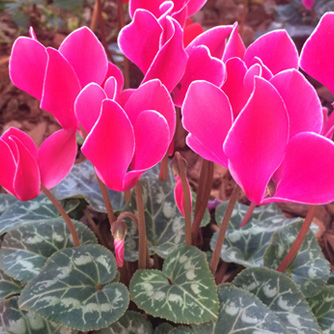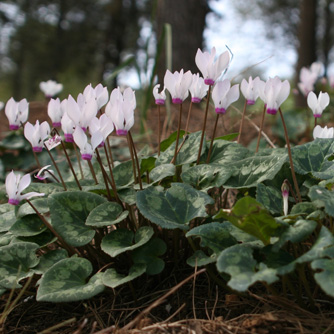Cyclamen
BackCyclamen are charming plants grown for their distinctive nodding flowers with upturned petals. These elegant flowers are long lasting and come in shades of pink, purple, red and white. The flowers stand high above patterned leaves which makes for a stunning plant. And if that’s not enough some cyclamen varieties are even fragrant!
There are around 20 different species of cyclamens with many originating from Europe and the Mediterranean. In Australia the most commonly grown type is Cyclamen persicum which produces large flowers in winter. They’re sold in nurseries and florists during the colder months as an indoor plant. If you’re lucky you may also find Cyclamen hederifolium sold as seedlings in nurseries. This smaller growing species does well in rockeries and garden beds and naturalises readily under deciduous trees. Flowering usually commences earlier than C. persicum.
How To Grow Cyclamen
Cyclamen grow from a swollen tuber and are usually purchased as an established plant or sometimes as seedlings. Cyclamen thrive in cooler temperatures with their growing period being autumn to spring. Over summer they die down and go dormant to avoid the hot, dry weather. They have a reputation for being difficult to look after but if you get the basics right they are actually very tough plants: give them bright light with good air circulation and avoid over watering or hot temperatures when in their growth cycle.

Cyclamens are available in a mix of vibrant colours
Indoor plants – choose a bright position, away from direct sunlight and heaters. If kept in a heated room then place the pot outside each night to allow the plant to soak up the cool air which they love. When watering avoid wetting the leaves or tuber and allow the potting mix to dry out between drinks. Do not sit in water filled saucers and allow space around the pot for good air circulation.
Outdoor plants – if keeping your cyclamen in a pot then choose a bright position, avoiding direct sunlight, and follow the same watering regime as for indoor plants. If you want to plant into the ground the soil needs to have perfect drainage otherwise the tuber will rot. The soil also needs to be rich and fertile so work in compost and manures beforehand. Plant so the tuber sits just above the ground and water in with OCP eco-seaweed. Please note: For most people the large flowering cyclamens don’t grow well in the ground and are best kept as potted plants. The smaller growing Cyclamen hederifolium is a better choice and will naturalise in fertile free draining soils.
Fertilising Cyclamen
Regular feeding with a combination of OCP eco-seaweed and OCP eco-aminogro will provide you with months of flowers and maintain strong healthy plants. Apply every 2-3 weeks to keep the flowers coming! Cyclamens planted in the garden will also benefit from an organic pelletised fertiliser at the end of summer or early autumn when they start to push out new growth.

Cyclamen flowers can also be two toned
Maintenance of Cyclamen
Regularly remove yellowing leaves or finished flowers by twisting the stem off at the base of the tuber with your fingers. Removal at the base means there are no stubs left to rot and cause possible problems.
As the temperature warms up in spring cyclamen will start to yellow and die down. That’s your cue to decrease watering to prevent the tuber rotting. Plants in pots can be placed outside in a shaded area where they’ll be kept dry until the following autumn. In autumn when new growth starts appearing on top of the tuber it’s time to begin watering and fertilising again.
After a couple of years in a pot you should refresh the potting mix and increase the pot size if necessary. Repotting is best done in late summer just before the cyclamen starts it’s growth cycle. Use a premium quality potting mix that is free draining and remember to not plant the tuber too deep. Keep the top of the tuber showing to avoid rotting issues. Water in with OCP eco-seaweed to reduce stress and encourage root development.
Propagation of cyclamen is by division of tubers or by sowing seed. Use a sharp knife to cut the tuber into smaller sections when the tuber is dormant. Each new section must have an “eye” or growing point so it’s best to divide the tuber like cutting up a pie. Plant into free draining potting mix and keep on the dry side as there is a significant risk of the segments rotting. For seeds let some of the spent flowers stay on the plant and develop seed pods. When seeds are ripe the stem will brown and curl down. Open the pod to remove the seeds and sow them in a tray of free draining potting mix. They should be covered with enough soil to exclude light. You can also allow the seeds to dry out and sow them the following autumn. Soaking seed overnight in OCP eco-seaweed can help with the germination process which usually takes about 3 weeks.

Both the cyclamen flowers and leaves are eye catching!
Pests and Diseases of Cyclamen
There are several sap sucking pests which commonly attack cyclamen including aphids, mealybug and mites. If you get an outbreak spray with OCP eco-oil or OCP eco-neem as required.
Yellowing leaves, collapsing flowers stems and rotting tubers are signs of over watering and/or poor drainage. Allow the plants to go a bit dry before rushing to water them and avoid wetting the foliage or tuber. Repot into a better draining potting mix if necessary.
Botrytis or grey mould is a fungal disease that may also develop in over watered plants. It can result in plant death so avoid the problem by not over watering.
Powdery mildew is another fungal disease that appears as a white or light grey coating over foliage. It is easily treated by spraying with an organic fungicide and increasing air circulation around the plant. Avoid wetting leaves when watering.
Indoor plants with yellowing leaves and general poor health (without rotting issues) are most likely suffering from excess heat. Remember these guys like cool conditions and indoor heating takes it’s toll on them. Move the plant to a cooler room or get into the habit of resting it overnight outdoors in the colder air.
In general maintain strong healthy plants by applying OCP eco-seaweed and OCP eco-aminogro every 2-3 weeks. You’ll get better flowering and improved resistance to pests and diseases as well.

Naturalised cyclamen look lovely under trees


